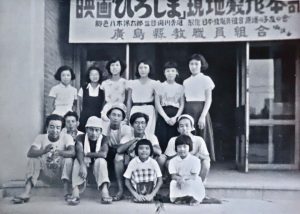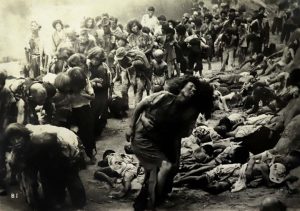Documenting Hiroshima 80 years after A-bombing: In summer of 1953, film Hiroshima produced, with A-bomb survivors reenacting tragedy
Feb. 27, 2025
by Minami Yamashita, Staff Writer, and Kyosuke Mizukawa, Senior Staff Writer
In the summer of 1953, Yuriko Hayashi, 88, then a second-year student at Motomachi High School and now a resident of Hiroshima City’s Asaminami Ward, would pay a visit to the Education Hall near Hiroshima City Hall almost every day. The center housed the local production headquarters for Hiroshima, a movie adapted from Genbaku no Ko (in English, ‘Children of the A-bomb’), a collection of personal accounts published in 1951. Ms. Hayashi would gather up rubble to be used in the filming and haul it to the production headquarters.
88,000 people participated in film production
The Japan Teachers’ Union (Nikkyoso in Japanese) raised funds for production of the film, which was directed by Hideo Sekigawa. Another film titled Children of Hiroshima based on the same collection had already been released the previous year, but the new film planned to replicate the tragedy of the atomic bombing more vividly. The filming began in Hiroshima City in May 1953, with around 88,000 citizens, including A-bomb survivors, widely recruited to serve as extras in the film. A group called Friends of the Children of the Atomic Bomb, formed of those who had submitted personal accounts for the original book, cooperated in the film-production work, and Ms. Hayashi was one of those people.
“I don’t remember having received any direction for my acting. Tears naturally welled up in my eyes during my performance from flashbacks of that time,” she said. On August 6, 1945, Ms. Hayashi, who was nine at the time, experienced the atomic bombing 1.6 kilometers from the hypocenter. For the film, smearing her face with charcoal, she played the role of a citizen right after the bombing based on images etched into her memory. Moreover, after receiving permission from the film crew, she tore and singed her costume to faithfully replicate actual clothing damaged in the bombing.
Filming locations also included Hijiyama Hill, where the wounded had fled, and Ninoshima Island, where survivors had been taken after the atomic bombing. Yumeji Tsukioka, an actor originally from Hiroshima City who died in 2017 at the age of 95, appeared in the film in an unpaid role, playing the part of a teacher who had died in the bombing alongside girl students she had led in building-demolition work.
Demand for cutting scenes
Nevertheless, the major company involved in production of the film demanded that scenes be cut. The company argued that “the film is influenced by too much anti-American sentiment,” as described in an article published in the Chugoku Shimbun on September 6, 1953. Although a ceasefire agreement in the Korean War had been reached in July, tensions between the United States and the Soviet Union continued.
One line in the film deemed problematic read, “We were used as guinea pigs in a nuclear-weapon experiment.” But Ms. Hayashi said, based on her humiliating experience in examinations conducted by the Atomic Bomb Casualty Commission (ABCC; present-day Radiation Effects Research Foundation), “That didn’t feel out of line to me.” She added, “Because pictures were taken of me and my blood was drawn while I wore nothing but a fundoshi loincloth.” The Nikkyoso teachers’ union refused to follow the demand to cut the scenes, which led to the film not being distributed by major companies and only being shown at limited locations starting in October.
While the film worked to recreate the scenes in Hiroshima soon after the atomic bombing, the inhumane consequences of the bombing persisted in the real world. In 1952, the previous year, Takuso Yamawaki, a physician at the Hiroshima Red Cross Hospital, had reported that A-bomb survivors were suffering high rates of leukemia based on his thorough investigation of A-bomb victims’ death certificates. Media reports about that issue began to increase.
Even among those working at ABCC, an organization criticized for “not providing treatment for survivors,” one person was deeply affected by the survivors’ plight. William Moloney was a U.S. physician with a specialty in hematology including leukemia who died in 1998 at the age of 90. An entry in his journal (archived at the U.S. Texas Medical Center) dated September 1953, reads, “What international boundaries are there on human suffering or pity?”
Prompting Mr. Moloney to think in those terms was his encounter with Masakazu Miyamoto, then a third-year student at Minami Elementary School (in Hiroshima’s present-day Minami Ward), who had been diagnosed with leukemia in an ABCC health examination. He wrote in his journal about how the Masakazu had a beautiful smile, reminiscent of “Tommy” (information hereunder has similarly been adapted from his journal). The boy’s innocence had reminded the physician of his own son.
He also wrote about his wish to add something to the knowledge base needed to defeat leukemia. He provided a new drug, which he had on hand for research purposes, to a local physician caring for Mr. Miyamoto out of personal interest rather than based on organizational policy. Masazuki’s condition improved at one point, but he passed away in February 1954. He was nine years old.
(Originally published on February 27, 2025)
In the summer of 1953, Yuriko Hayashi, 88, then a second-year student at Motomachi High School and now a resident of Hiroshima City’s Asaminami Ward, would pay a visit to the Education Hall near Hiroshima City Hall almost every day. The center housed the local production headquarters for Hiroshima, a movie adapted from Genbaku no Ko (in English, ‘Children of the A-bomb’), a collection of personal accounts published in 1951. Ms. Hayashi would gather up rubble to be used in the filming and haul it to the production headquarters.
88,000 people participated in film production
The Japan Teachers’ Union (Nikkyoso in Japanese) raised funds for production of the film, which was directed by Hideo Sekigawa. Another film titled Children of Hiroshima based on the same collection had already been released the previous year, but the new film planned to replicate the tragedy of the atomic bombing more vividly. The filming began in Hiroshima City in May 1953, with around 88,000 citizens, including A-bomb survivors, widely recruited to serve as extras in the film. A group called Friends of the Children of the Atomic Bomb, formed of those who had submitted personal accounts for the original book, cooperated in the film-production work, and Ms. Hayashi was one of those people.
“I don’t remember having received any direction for my acting. Tears naturally welled up in my eyes during my performance from flashbacks of that time,” she said. On August 6, 1945, Ms. Hayashi, who was nine at the time, experienced the atomic bombing 1.6 kilometers from the hypocenter. For the film, smearing her face with charcoal, she played the role of a citizen right after the bombing based on images etched into her memory. Moreover, after receiving permission from the film crew, she tore and singed her costume to faithfully replicate actual clothing damaged in the bombing.
Filming locations also included Hijiyama Hill, where the wounded had fled, and Ninoshima Island, where survivors had been taken after the atomic bombing. Yumeji Tsukioka, an actor originally from Hiroshima City who died in 2017 at the age of 95, appeared in the film in an unpaid role, playing the part of a teacher who had died in the bombing alongside girl students she had led in building-demolition work.
Demand for cutting scenes
Nevertheless, the major company involved in production of the film demanded that scenes be cut. The company argued that “the film is influenced by too much anti-American sentiment,” as described in an article published in the Chugoku Shimbun on September 6, 1953. Although a ceasefire agreement in the Korean War had been reached in July, tensions between the United States and the Soviet Union continued.
One line in the film deemed problematic read, “We were used as guinea pigs in a nuclear-weapon experiment.” But Ms. Hayashi said, based on her humiliating experience in examinations conducted by the Atomic Bomb Casualty Commission (ABCC; present-day Radiation Effects Research Foundation), “That didn’t feel out of line to me.” She added, “Because pictures were taken of me and my blood was drawn while I wore nothing but a fundoshi loincloth.” The Nikkyoso teachers’ union refused to follow the demand to cut the scenes, which led to the film not being distributed by major companies and only being shown at limited locations starting in October.
While the film worked to recreate the scenes in Hiroshima soon after the atomic bombing, the inhumane consequences of the bombing persisted in the real world. In 1952, the previous year, Takuso Yamawaki, a physician at the Hiroshima Red Cross Hospital, had reported that A-bomb survivors were suffering high rates of leukemia based on his thorough investigation of A-bomb victims’ death certificates. Media reports about that issue began to increase.
Even among those working at ABCC, an organization criticized for “not providing treatment for survivors,” one person was deeply affected by the survivors’ plight. William Moloney was a U.S. physician with a specialty in hematology including leukemia who died in 1998 at the age of 90. An entry in his journal (archived at the U.S. Texas Medical Center) dated September 1953, reads, “What international boundaries are there on human suffering or pity?”
Prompting Mr. Moloney to think in those terms was his encounter with Masakazu Miyamoto, then a third-year student at Minami Elementary School (in Hiroshima’s present-day Minami Ward), who had been diagnosed with leukemia in an ABCC health examination. He wrote in his journal about how the Masakazu had a beautiful smile, reminiscent of “Tommy” (information hereunder has similarly been adapted from his journal). The boy’s innocence had reminded the physician of his own son.
He also wrote about his wish to add something to the knowledge base needed to defeat leukemia. He provided a new drug, which he had on hand for research purposes, to a local physician caring for Mr. Miyamoto out of personal interest rather than based on organizational policy. Masazuki’s condition improved at one point, but he passed away in February 1954. He was nine years old.
(Originally published on February 27, 2025)









